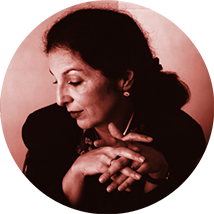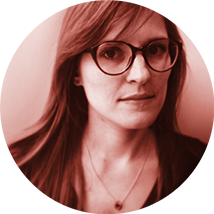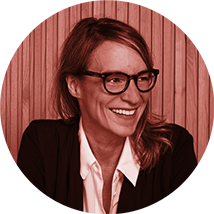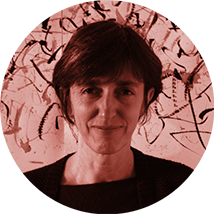Conference
June 7, 2019

You can see her latest works on her website and follow her on twitter.
It's an idea, a smell, a song, a memory, a personality, a warning, a taste, a seduction...
Sarah explores typefaces through the eyes of the type consumer. For the last few years she has taken her pop-up lab to events with a range of experiments designed to engage participants in thought-provoking activities while also gathering data she can then share. Her experiments include profiling typeface personalities, exploring letterforms as cultural codes, and investigating how type interacts with all the senses.
She will talk about some of her experiments, giving insights into the process and how some of the failed experiments have taught her the most. Be prepared to join in, her talks are fun and interactive with lots of games for the audience to take part in.

You can see her latest works on her website and follow her on twitter.
In my talk, I will introduce briefly how I started my career as a graphic designer and how later I became a professional type designer, and occasionally an author. I will put some emphasis on specific projects that had been relevant to me, from lettering to type design, always trying to emphasize my personal approach when designing Latin typefaces and also in relation to other writing systems.

Fili is the author of Elegantissima, Grafica della Strada, Graphique de la Rue and Grafica de les Rambles. She also co-authored and designed Italianissimo and The Cognoscenti's Guide to Florence. With her husband, the design historian Steven Heller, she is co-author of Italian Art Deco, British Modern, Dutch Moderne, Streamline, French Modern, Deco España, German Modern, Deco Type, Design Connoisseur, Counter Culture, Typology, Stylepedia, Euro Deco, Scripts, Shadow Type, Stencil Type, and Slab Serif Type. She has also designed Perfetto, Tutti Frutti, and Brillante pencils.
You can see her latest works on her website and follow her on twitter.
Louise’s over-40-year career has consistently been influenced by Italian typography, starting with her first visit at the age of sixteen, when a poster for Perugina motivated her to become a graphic designer. From book jackets to restaurants to food packaging, and most recently font design, every new chapter has been inspired by a trip to Italy. This talk will show the pasticceria papers discovered in a magazzino, the Deco beach signs of Viareggio, and typefaces inspired by Futurist and Stile Liberty letterforms—and how they have informed her work.

Prior to joining Hallmark Cards in 2013, she spent 7 years working in New York City and New Jersey as a graphic designer and lettering artist. Past clients include Princeton University, L’Oréal, Tattly, Coach, Condé Nast Digital, Starwood Hotels & Resorts Worldwide, and Martha Stewart Living Omnimedia.
She has a BFA in Graphic Design from Savannah College of Art and Design, and is a graduate of Type@Cooper Extended in New York City.
You can see her latest works on her website and follow her on instragram account.
A Look Into the Typefaces Created and Developed by Women at Hallmark
Several years ago, a graphic designer decided to make a radical change and leave New York City to design fonts for a well-known Midwestern greeting card company.
Much to her surprise, she discovered that a majority of the fonts she was developing were based off of lettering created by female illustrators, designers, and lettering artists.
Join Font Designer Lila Symons for an engaging and informative introduction to the numerous women with whom she has collaborated with over the years at Hallmark Cards.
She will share “what it’s like” to be a female in-house typeface designer and how working alongside pre-eminent female artists and makers has resulted in the production of many new fonts for Hallmark’s proprietary type library. Learn how these collaborations have inspired her own lettering and font work both as a developer and lettering source.

Her work encompasses brand identities, editorial and exhibition design, wayfinding systems and packaging for clients such as Phaidon, Camper, Laurence King, The National Portrait Gallery, Reina Sofía Museum, Wallpaper* and Cahiers du Cinéma. Stavro’s work has received over 150 international awards. Her work has been widely published and exhibited and Stavro has chaired and judged numerous international design competitions. She has written articles for top international design journals and is frequently asked to speak at conferences across the globe. Stavro has taught at Central Saint Martins College of Art & Design and is currently a Visiting Lecturer at the Royal College of Art. She was elected a member of Alliance Graphique Internationale in 2010. Stavro was born in Trieste, Italy and studied graphic design at Central Saint Martins College of Art & Design (BA) and the Royal College of Art (MA).
You can see her latest works on her website and follow her on twitter account.
Astrid will talk about her lifelong obsession with the smell, the sound and the tactility of ink and paper.

Last year she teamed up with letterer and writer Chris Campe and wrote the book “Making Fonts!”, a comprehensive guide to type design & font production.'
You can see her latest works on her website and follow her on twitter and instagram accounts.
Because the fonts Ulrike Rausch designs look handmade, many people picture her working with pen and paper all day. But no! The path from the first sketches to a fully functioning font is not a purely analog process, it’s rather a pretty geeky software endeavor.
In her talk, Ulrike shows how she designs typefaces and how she builds fonts. Ulrike will also demonstrate how nerdy OpenType programming adds just the right analog touch to her handwriting style. You will learn how to use pro fonts like a pro—no matter if you use layout software like Adobe InDesign or a standard word processor like Microsoft Word.

You can see her latest works on her website and follow her on twitter and instagram accounts.
All my artwork and teachings have a foundation in handwriting as an art of being present, an art of living, an art of direct experience. I will talk about handwriting as a method, a work rule: beyond technique, beyond control, beyond the grid, beyond geometry, beyond screens. This means placing the experience of doing at the center, in an apparent inefficiency of time. Handwriting is a visual manifestation of a culture, an expression of human creativity in all its diversity. Handwriting is alive and belongs to everybody. We are also used to think of writing as being totally at the service of reading, but the act of writing can take a stand of its own, independent from the act of reading, because writing and reading are two separate activities. In my work I often don’t recognize the hierarchy of reading over writing. Legible writing can be inappropriate to communicate certain feelings, typography, even more so, locks thought into a given shape.

You can see his latest works on his website and follow him on twitter.
Tipoteca Italiana is a printing museum acclaimed for the depth and quality of its array of equipment, tools and documentary material—and also for the beauty of its installation. “Memory is the means by which we draw on our past experiences in order to use this information in the present. Memory is essential to all our lives. Without a memory of the past, we cannot operate in the present or think about the future.” This assumption applies to men as well as to typography. A printing museum today is not only a storage of memory, but a place for its ‘digital’ retrieval.




















